The Haswell Ultrabook Review: Core i7-4500U Tested
by Anand Lal Shimpi on June 9, 2013 9:00 AM ESTGPU Performance
With a modest increase in EU hardware (20 EUs up from 16 EUs), the Intel HD 4400 GPU in the Core i7-4500U I’m testing today isn’t tremendously faster compared to the HD 4000 in the i7-3517U. On average I measured a 15% increase in the subset of game tests I was able to run in Taipei, and a 13% increase in performance across our 3DMark tests. The peak theoretical increase in performance we should see here (taking into account EU and frequency differences) is 19%, so it doesn’t look like Haswell is memory bandwidth limited just yet.
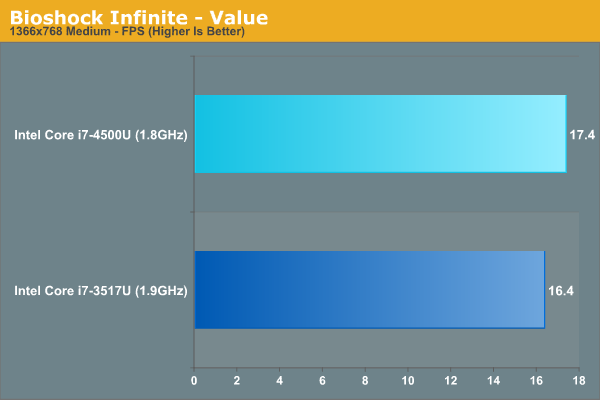
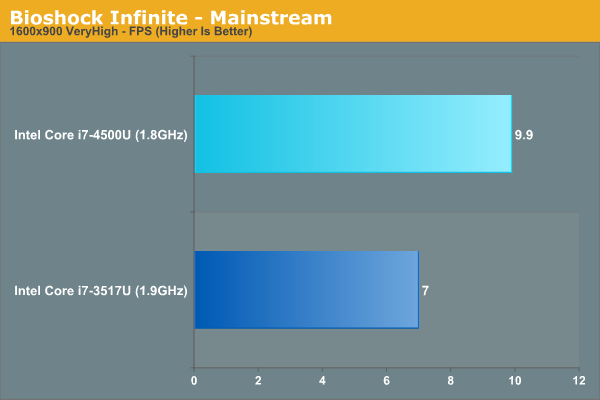
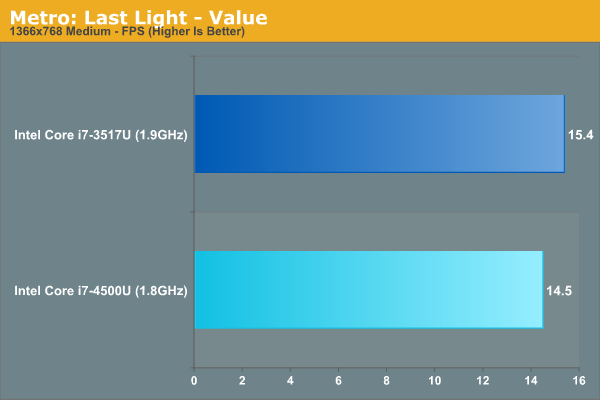
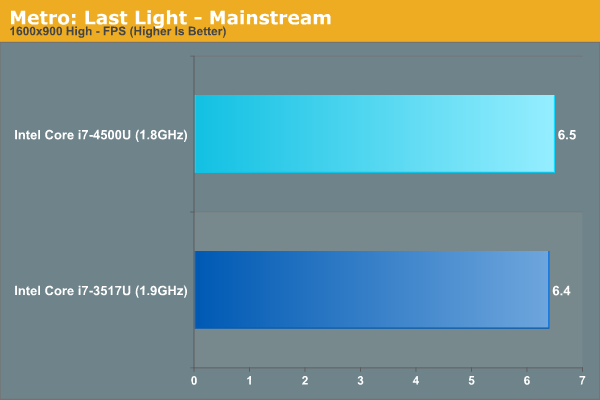
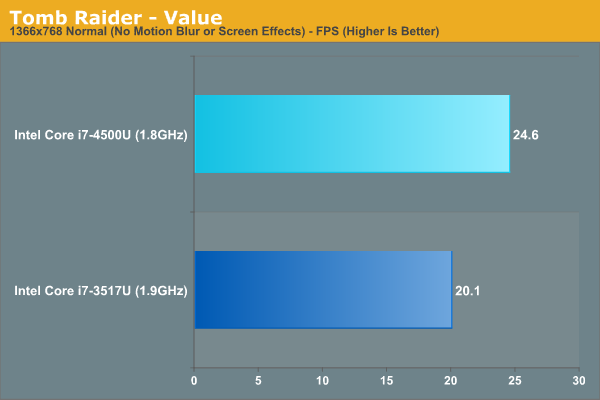
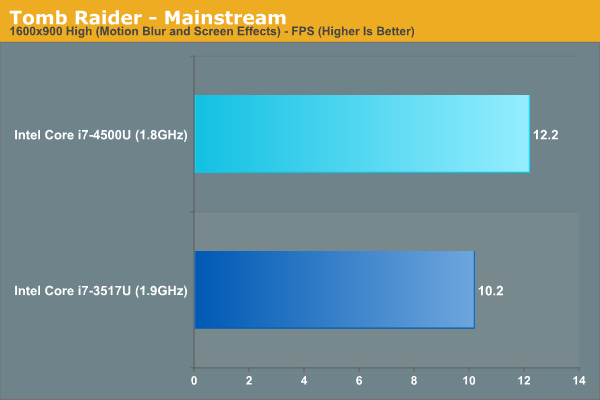


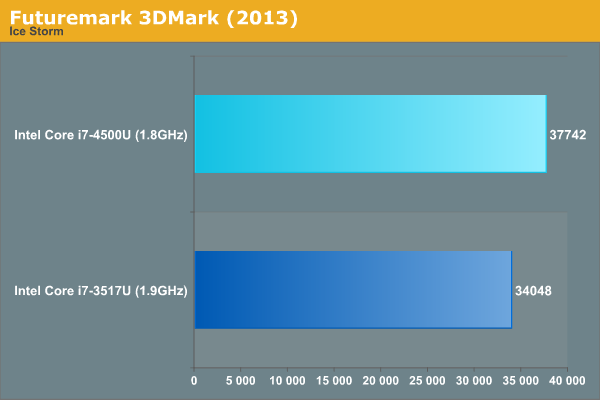
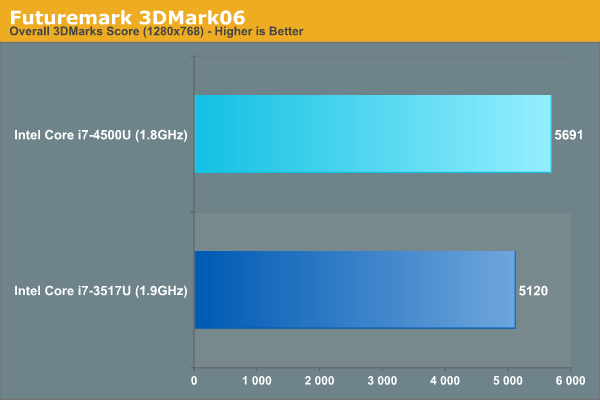
If we throw 35W Trinity into the mix, HD 4400 gets closer but it's still far away from 35W Trinity performance:
| GPU Performance Comparison | ||||||
| Metro: LL - Value | Metro: LL - Mainstream | BioShock Infinite - Value | BioShock Infinite - Mainstream | Tomb Raider - Value | Tomb Raider - Mainstream | |
| Core i7-3517U | 15.4 fps | 6.0 fps | 16.4 fps | 7.0 fps | 20.1 fps | 10.2 fps |
| Core i7-4500U | 14.5 fps | 6.5 fps | 17.4 fps | 9.9 fps | 24.6 fps | 12.2 fps |
| A10-4600M | 16.8 fps | 8.0 fps | 25.8 fps | 10.0 fps | 30.1 fps | 12.7 fps |
For light gaming, Intel’s HD 4000 was borderline reasonable. Intel’s HD 4400 takes half a step forward, but it doesn't dramatically change the playability of games that HD 4000 couldn't run well. Personally I’m very interested to see how the 28W Iris 5100 based Haswell ULT part fares later this year.










87 Comments
View All Comments
StealthGhost - Sunday, June 9, 2013 - link
Is PCMark 8 Home less demanding than 1080p video? If not, it doesn't seem like the Asus can call itself an Ultrabook.Still, impressive gains in battery life. I hope this will carry over, to some extent at least, into the CPUs that will be in laptops like the MacBook Pros. Guess we will have to see when that review comes out =)
StealthGhost - Sunday, June 9, 2013 - link
*AcerDeath666Angel - Sunday, June 9, 2013 - link
As far as I know the Ultrabook specs don't define a minimum luminance for the display. So Anand's test isn't relevant for the Ultrabook spec.axien86 - Sunday, June 9, 2013 - link
Laptopmag just reviewed the Sony Vaio based on the i7-4500u and they also noted that performance wise the Haswell offered marginal improvement over Ivy Bridge laptops, while battery life was indicated as improved.One important characteristic that most laptop users want to know is regards to heat and fan noise. Laptopmag found that the Haswell i7-4500u based Sony Vaio found that the back of the laptop "reached a more troubling 110 degrees." They also found fan noise was definitely noticeable in a quiet room just running Word and a Youtube video.
http://www.laptopmag.com/reviews/laptops/sony-vaio...
The question is, why hasn't Anandtech run extensive temperature and noise characteristic analysis on Intel Haswell processors and your current laptop?
Kristian Vättö - Sunday, June 9, 2013 - link
Likely because of lack of time. As Anand said in the article, he got the unit while in Computex, so basically he did the review between meetings. I'm pretty sure he didn't have the equipment with him to do temperature or noise tests properly but I'm sure this is something that will be tested in later reviews.Also, keep in mind that heat and fan noise are system-dependent. If the Vaio has poor cooling, then it will be hot and loud but that's not Haswell's fault (I'm not saying this is the case but we obviously need more reviews before any conclusions can be drawn).
mavere - Sunday, June 9, 2013 - link
"The question is, why hasn't Anandtech run extensive temperature and noise characteristic analysis on Intel Haswell processors and your current laptop?"The WHr of battery that a laptop consumes is the exact same thing as its heat output.
Anand is trying to test the Haswell platform, not the design deficiencies of any specific manufacturer. Sony's problems are its own.
n13L5 - Sunday, June 9, 2013 - link
Cause they had to run their test in Taiwan with a borrowed machine?I was rather disturbed by the temperature of Sony's Vaio Pro, as well as the instability of the carbon case, which must be paper thin... And their keyboard backlight has the worst bleed I've ever seen, they should have a look at Lenovo and Samsung keyboards...
Well, I'll be waiting for more tests and the ULT Haswell with the Iris 5100 GPU. Maybe that'll rack up a high enough temperature to fry a steak.
akbisw - Monday, June 10, 2013 - link
Sony has terrible cooling system in their laptops in general. The worst I have seen done by any manufacturer. Even my my old acer before their "reiteration" had better cooling design than current VAIO systems.Dnann - Friday, June 14, 2013 - link
He probably didn't have the time considering the circumstances...DanNeely - Sunday, June 9, 2013 - link
The fact that companies historically known for horrible battery life are getting good results out of Haswell with Intel's help is promising; but starting from such a horribly low baseline makes getting gains much easier. I'm much more interested in seeing what companies who've historically offered good battery run times will be able to do with Haswell.